Opinion
Are NFTs the Next Tulip Bubble? Kenny Schachter Doesn’t Care—and He Sold His Own Grandma on the Crypto Web to Prove It
Our columnist is so all-in on NFTs you won't believe it.
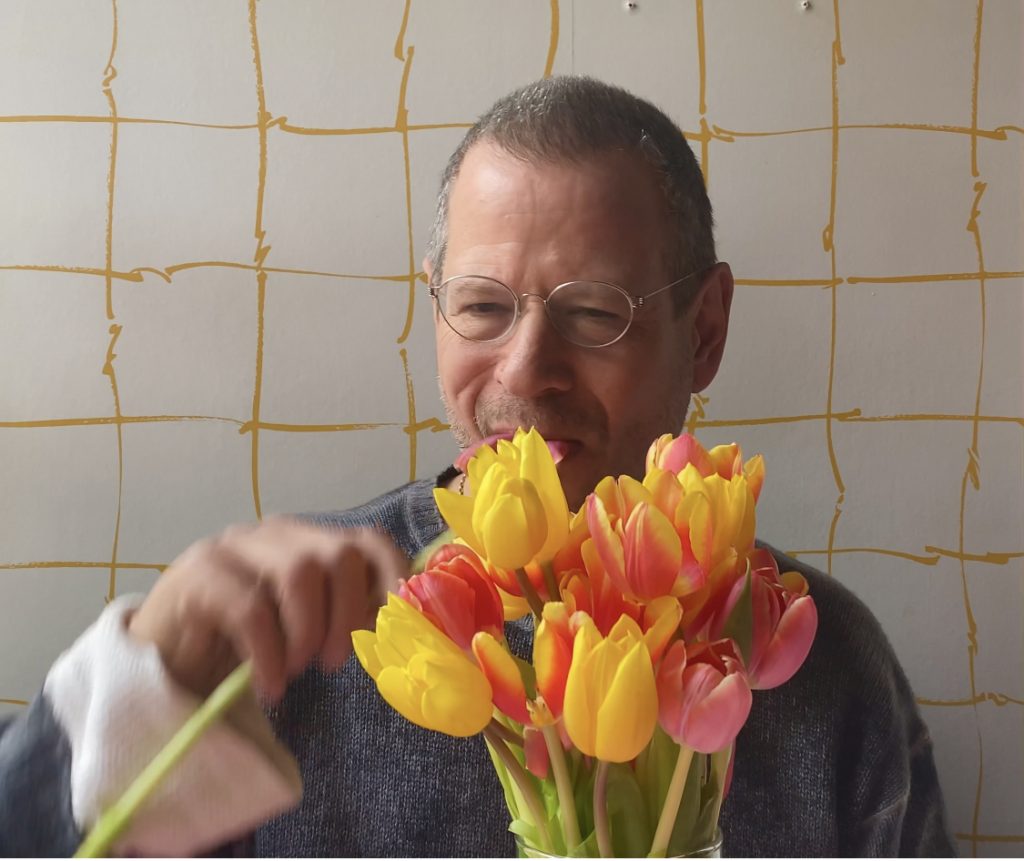
Our columnist is so all-in on NFTs you won't believe it.

Kenny Schachter

It took the world centuries to stop talking (and thinking) about the artiness of art and denigrate the discussion to the level of pure dollars—whereas the newly minted NFT space still hasn’t gotten around to the art part of the conversation since its inception. Granted, in crypto land the notion of time has been warped by the momentum of changes moving faster than the speed of light. A better analogy is dog years: one year on the blockchain is akin to seven in real life (though what exactly that is anymore is anyone’s guess). As you may already know, two weeks ago, I wrote a column here on Artnet News about non-fungible tokens and damn… my life has been turned topsy-turvy ever since.
After receiving more than 500 emails, DMs, and phone calls—and, please take note, calls are the least tolerable for me—from artists, architects, dealers, and sundry other prospectors about how they too could join the blockchain-gravy train, I actually contemplated opening an NFT advisory service; I’d probably stand to earn more than my recent lucrative Nifty Gateway drop. Wading through all the enquires has amounted to a veritable full-time job—which, ugh, is not what I signed up for. If a revolution is a sudden and abrupt political change occurring after a popular uprising, the velocity at which the art world has cottoned onto the NFT craze (or tried to, in any event) is actually a little revolting. Like the first shot that rings out at the beginning of war, as soon as the crypto cash register’s cha-ching sounded far and wide everyone and their grandmother wanted in. (More on my grandmother in a bit.)
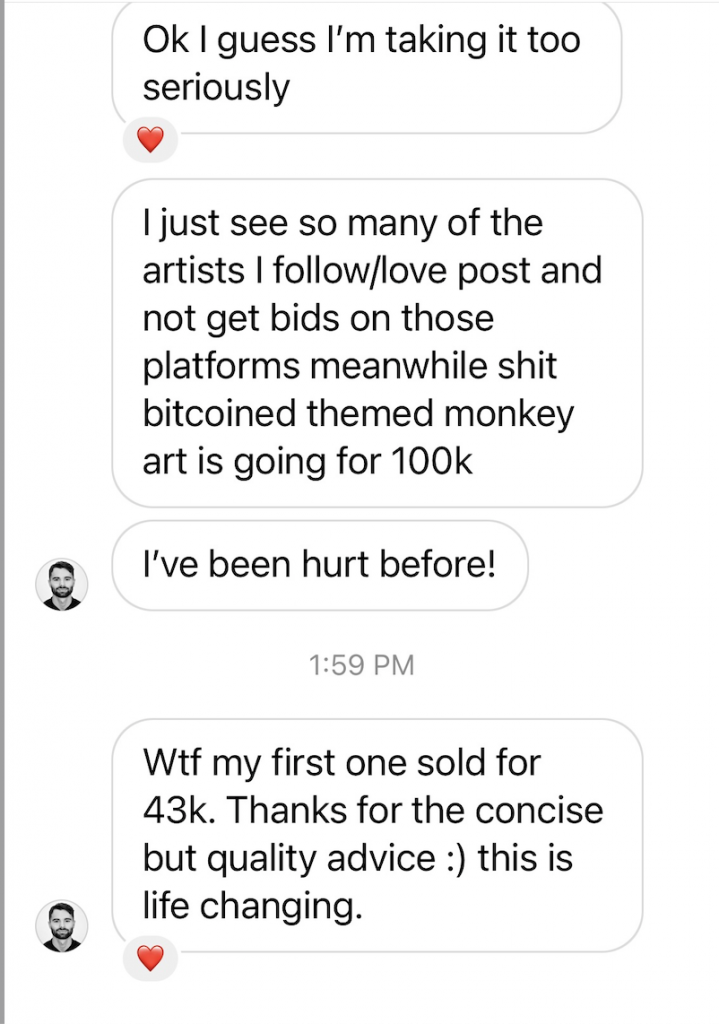
This is as great as doing it myself! Courtesy of Kenny Schachter.
Now that there’s a gold rush of old-guard gallery, art-fair, biennial, and auction types (and artists) foaming at the mouth to join the digital natives and crypto investors (i.e., kids and tech bros, generally speaking) fueling the frenzy. What the naysayers are missing is that this is a) a fresh and burgeoning body of buyers new to collecting that b) found a way to obviate the traditional system of gatekeeping galleries and just gain direct access to the art. That my article helped inspire many who have long toiled in the digital realm with little or no remuneration to jump into the scrum is actually very affecting. Such sentiments as “you changed my life” were not unusual among the glut of messages I answered trying to help people get started. Though I can’t think of anything more divisive than NFTs today, in my three-decade-long career I’ve never seen anything stir up shit and take hold so utterly swiftly. You ignore this movement (and it’s nothing less) at your own expense. Trust me.
I was bound to get a couple of things wrong last time, on the tech side anyway—but thankfully most denizens of the art world aren’t savvy enough in that regard (yet) to have attacked me for it, as they are wont to do. The art part of NFTs don’t live on the blockchain, but rather on the InterPlanetary File System (IPFS, see glossary), which is a peer-to-peer computer network for storing and sharing data in a distributed fashion. There are many potential problems on the horizon for which no ready answers seem to exist. What if the IPFS is hacked, or the businesses running them somehow go under? Could there be NFTs shorn of their art? (some would say that’s the case already!) One DM-er complained that they couldn’t find any details relating to the technical requirements for image resolution sizes (there are none) and whether TIFF files are the best format because they are the most stable (probably yes, but anything goes as of now).
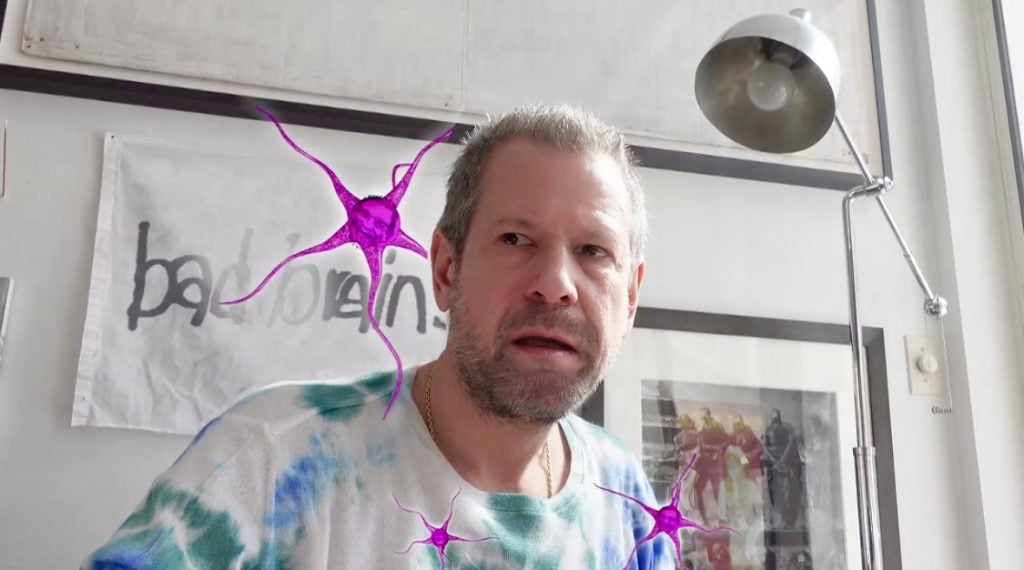
Brain cells are terrible things to waste…so I minted mine and made another NFT. Can you blame me? Courtesy of Kenny Schachter.
And, umm, what will the IRS make of NFTs when they stick their fat nose into this market in a short matter of time, and how will compliance regulations mandating KYC (Know Your Client) be interpreted with regard to all this? Yes, NFTs will probably last in some form as we sort of know them now, but possibly not exactly as they exist today. For example, transacting in Ethereum—today’s NFT crypto standard—is as prohibitively expensive to process as it is exorbitant in energy usage. Will Polkadot or Cardono replace ETH? Funny enough, or not so funny, many of these digital currencies originate in a tiny tax haven in Switzerland.
I am curating an NFT exhibition called “Breadcrumbs” (see my glossary—this is nothing less than a new language) at the esteemed German conceptual gallery Nagel-Draxler on April 9th and also, simultaneously, at two virtual crypto museums: the Museum of Crypto Art (MOC△) with Colborn Bell, and the Museum of Contemporary Digital Art (MoCDA) with Serena Tabacchi and Georg Bak. By the way, there are already more crypto museums in existence, and why not? It doesn’t take much to buy some land in the Metaverse—just some more NFT tokens. Let’s leave that one for now.
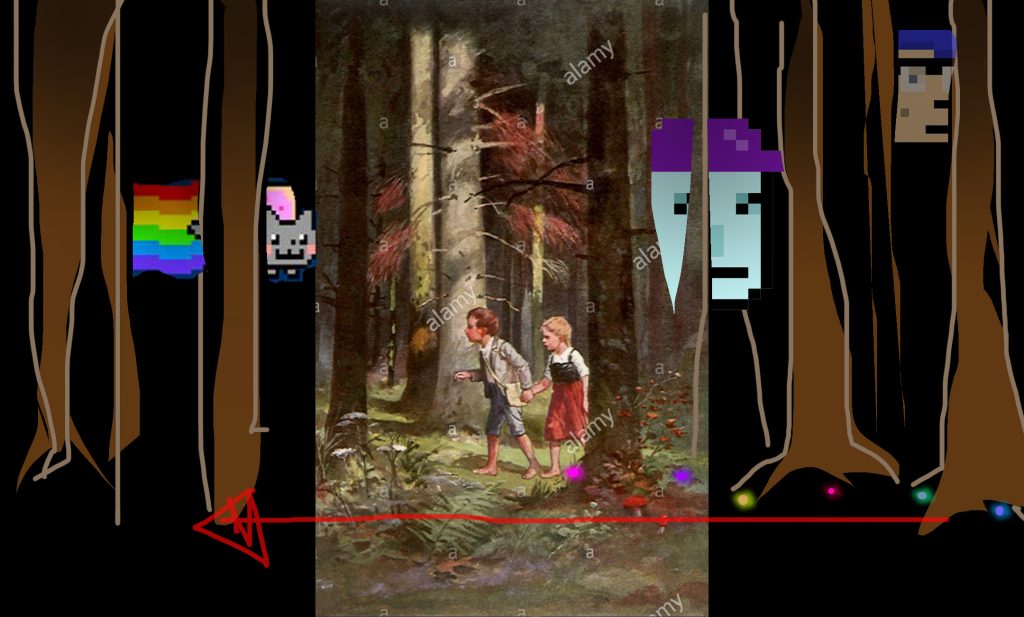
You want to know what an NFT show will look like? I will show you on April 9th when the show I curated, “Breadcrumbs,” opens at Galerie Nagel Draxler in Cologne and also in the Metaverse. Courtesy of Kenny Schachter.
The “Breadcrumbs” show(s) will provide a historical overview of the genre and its paragons (if you can call a few years history), including Kevin Abosch, a pioneer in the field but first and foremost an artist, who described his forays into NFTs as “layers of hexadecimal code, alphanumerical proxies to distill emotional value.” So not too dissimilar to a landscape, right? But Darren Bader and Sanya Kantorovsky, who both use digital means to express themselves in a way that is part and parcel of their artistic practice, will also participate. In related news, Johann König is curating a digital art show (though not strictly comprised of NFTs) with Anika Meier, and the UCCA—the “museum” in Beijing that was recently sold to a private equity company, kind of like an NTF itself—will also host an NFT exhibition. The future is now.
The students in the history of design class I’m teaching at New York University this semester asked so many NFT questions before the last lecture that I barely got a word in edgewise on De Stijl or the Bauhaus, so before the next class I asked them if I should just teach NFTs and skip furniture and design altogether. Not only did they resoundingly agree, but half a dozen more students audited the class—including two of my own kids! The lecture ran an hour over schedule, reaching nearly three hours total. I needed a nap after. (I hope NYU doesn’t hear about it, or read this.)
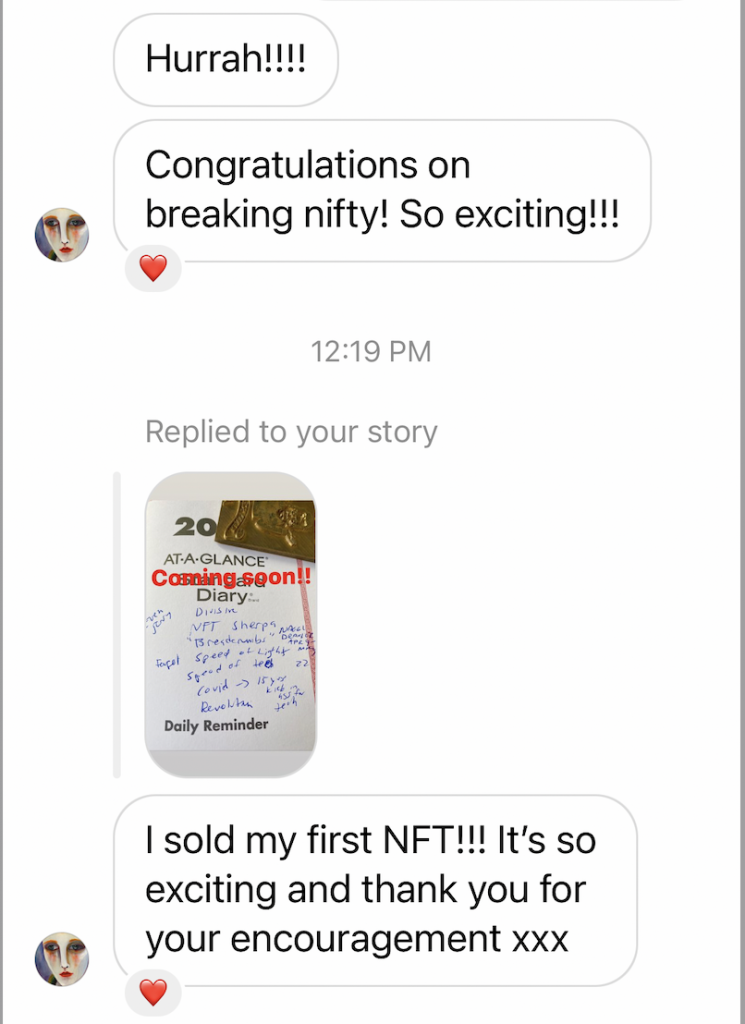
You spend the beginning of your life learning, and the rest sharing. Courtesy of Kenny Schachter.
Many think this is a fad, nothing more than a rug-pull. Well, if it’s a bubble—and I suggest it’s not—well, that’s still soap, and that’s not nothing. In the 1630s, the price of a tulip bulb reached the equivalent of a fully fitted-out mansion—irrational exuberance, to put it mildly—but then during World War II the Dutch ate the bulbs (even though the centers are poisonous) to sustain themselves through wartime famine. And we still enjoy tulips, don’t we? Looking at them anyway. For 25 years I have been contacted by newspapers to comment on this or that art bubble, and yet the art world has miraculously managed to not only survive but thrive, growing bigger than ever before in the process. To prove a point, I ate a dozen tulips and entitled the video Eating the Bubble—and I’m still alive, albeit barely.
NFTs are not all about money, or don’t always work out that way. True, DJ and digital artist 3LAU had a drop recently that netted $11.7 million, but he’s also among the first audiovisual artists to do so. Things didn’t go exactly as planned when the hot indie band Kings of Leon began the release of their latest album for $50, which resulted in “gas” fees (see glossary) said to reach $70 and far fewer sales than anticipated. Upstart rats.art is a decentralized (and, god, that term is abused as much as “important” in the old art world) online artists’ collective framed as an experiment in an arts-based economy where you can trade NFT art for a rats token that in turn can be traded for another NFT. So, it’s good to know it’s not all just about trading money—at least in this instance. where if you put one in, you can take one out.
Being a proud (some would say pushy) father, I coached Adrian, my 24-year-old, to mint an NFT. Gabriel, my 21-year-old, is working on a tokenized deal of his own with his Egyptian friend who’s dad is a legendary singer—I trust he told him (Amr Diab) about it. Sage, my 18-year-old, is transferring into art school—so he’s next! Being a dilettante was historically looked upon as a good thing—but in the art world, sadly, you’re dismissively pigeonholed if you do too many disparate things. This hasn’t served me well as the ultimate hyphenate: a writer-artist-curator-teacher-dealer. But in the world of NFTs most are DeFi (last time I ask you, see glossary) folks who are also techies and digital artists.
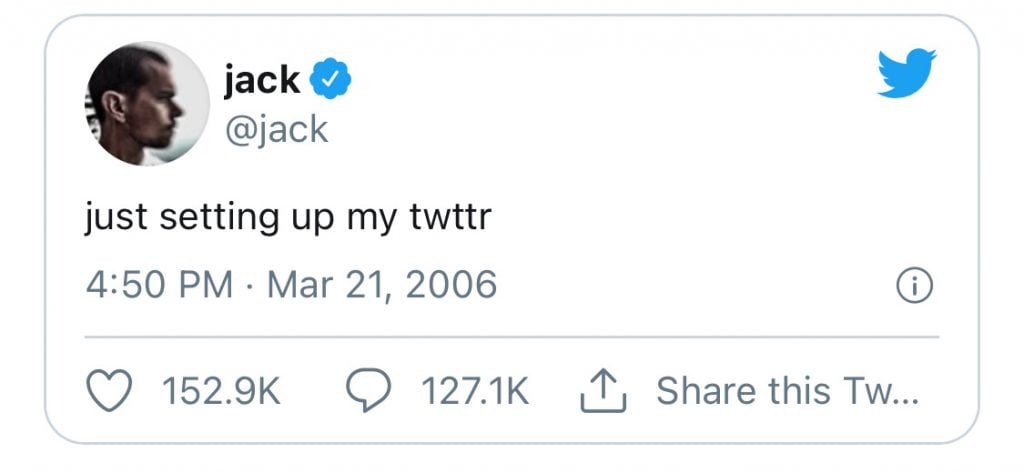
Air never tasted so…expensive. Jack Dorsey’s $2.5 million tweet. Courtesy of Kenny Schachter.
I won’t say the learning curve and subsequent onslaught hasn’t been tiresome. I found myself repeatedly stating that everyone and their grandmother is minting NFTs now, or wants to—which inspired the idea to upload my grandma and mint her on OpenSea. In no time I got three offers, caved, and sold her for a few grand. Maybe I let her go too cheaply. Twitter founder Jack Dorsey is selling his first tweet (I describe how in my last column) and the bid stands at $2.5 million as I write. If that’s so, this article should be worth a pretty (digital) penny.
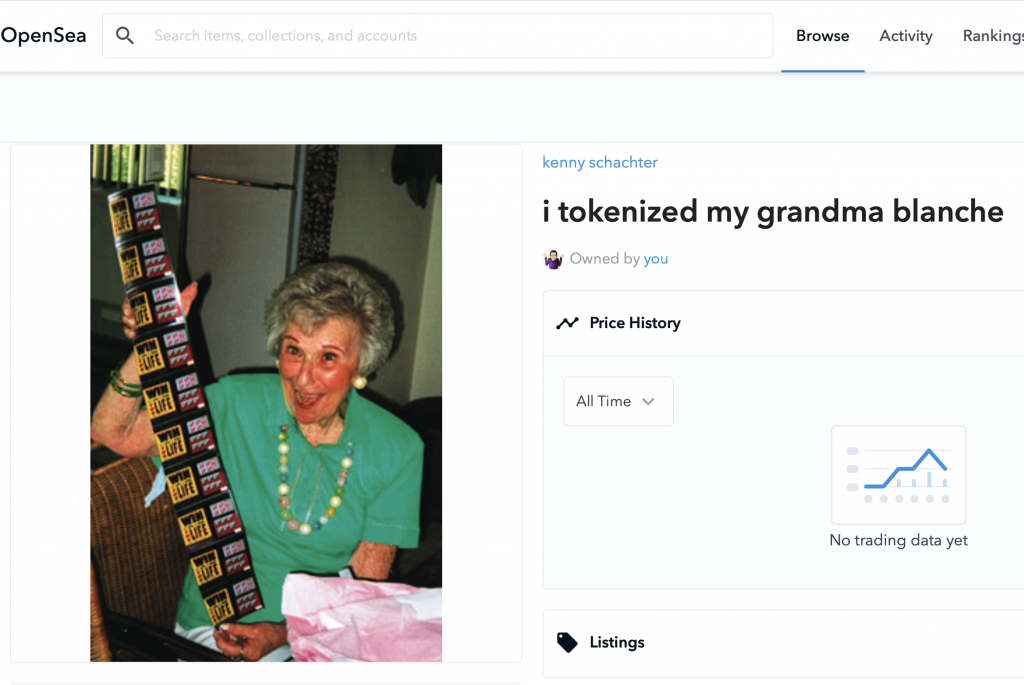
Sell the wife, kids, car, and… grandmother? Yup, and after three quick offers I let grannie go for a few thousand. Courtesy of Kenny Schachter.